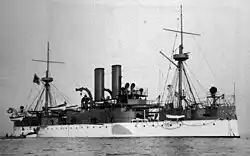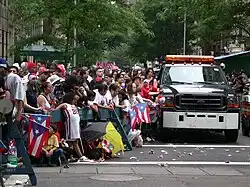
The Spanish-American War was a very short war which was fought between Spain and the United States between April and August 1898. It was caused by a diplomatic incident in February 1898 when the USS Maine sank in Havana harbor. Spain was involved at the time in a long-standing effort to crush a war of independence which had broken out in its colony of Cuba in 1895. Although the cause of the sinking of the Maine remains unclear to this day, the US government of the day used the incident as a justification for declaring war on Spain at the height of the age of imperialism. After a resounding victory over the Spanish, the US forced the government in Madrid to acknowledge the independence of Cuba and to cede its other colonies, the Philippines, Guam and Puerto Rico, to the United States. The war involved a considerable amount of migration from and to these colonies both during and after the conflict.[1]
Spanish-American War chronology of eventsSpanish-American War chronology of events
Spain had been the pre-eminent colonial power globally in the sixteenth and seventeenth centuries, with an empire that encompassed most of the Americas from California and Texas in the north to Tierra del Fuego at the southern tip of South America, while also holding many of the larger islands in the Caribbean and the Philippines and some other small islands in the Western Pacific. By the dawn of the eighteenth century, though, it was a rapidly declining power and nationalist movements began to emerge across South and Central America. These finally were provided with an opportunity to break from Spanish rule in the 1800s owing to the Napoleonic Wars back in Europe and the French occupation of Spain. Therefore countries like Mexico, Argentina, Peru, Gran Colombia and Chile were able to emerge in the 1810s and 1820s, ending Spain’s control off vast parts of the western hemisphere. By the second half of the nineteenth century it controlled only a small number of colonies of which Cuba, Puerto Rico, Guam and the Philippines were the most prized.[2]
There had been numerous efforts made by Cuban nationalists to end Spanish rule on the Caribbean island, most notably the Ten Years’ War between 1868 and 1878, but this had ultimately failed to end in a new Cuban state.[3] A new conflict, the Cuban War of Independence, erupted in 1895. The US government looked on as events unfolded over the next several years watching to see if its own interests were compromised in any way. Then, when the USS Maine sank in Havana harbor on the 15th of February 1898 it seemed to offer the perfect opportunity to intervene in the conflict in Cuba and shape developments to favor the US. The administration of President William McKinley issued an ultimatum calling for the Spanish to withdraw from Cuba and, when it was refused, declared war on Spain on the 21st of April 1898.[4]
The Spanish-American War which followed lasted just under four months. US expeditionary forces were dispatched to Cuba and to the Philippines and managed to inflict heavy defeats on the Spanish within weeks. This was combined with the potential threat to Spain itself as the US sent its ships out across the Atlantic to threaten the Iberian Peninsula. Faced with overwhelming odds the Spanish soon agreed to peace talks, while an armistice came into effect in August. The Treaty of Paris was agreed in December whereby Spain acknowledged the independence of Cuba and ceded the Philippines, Guam and Puerto Rico to the US.[5]
Extent of migration caused by the Spanish-American WarExtent of migration caused by the Spanish-American War
In the immediate aftermath of the war, Cuba emerged as an independent state, though one which was largely controlled by the Americans for several years as they managed its transition to becoming an independent democracy. Furthermore, even after the island nation emerged as an independent state it remained very closely aligned with the US, with a series of American-backed strongmen and politicians generally controlling the island nation down to the late 1950s when the Cuban Revolution led to the establishment of the communist regime of Fidel Castro. The period between 1898 and the 1950s saw the beginnings of Cuban migration to the United States and so the Spanish-American War was responsible for the inception of this migration.[6]
In the Pacific, the end of the war saw the US also move to establish an independent Philippine republic, but its arrival here met with opposition and the US-Philippine War followed between early 1899 and mid-1902. This too saw considerable migration both internally within the Philippines and a movement of American administrators to the island archipelago.[7] While the acquisition of Guam as a Pacific territory of the United States, a status which it has retained for a century and a quarter, involved little migration, Puerto Rico’s establishment as an American overseas territory resulted in the inception of Puerto Rican migration to the United States from 1898 onwards.
Demographic impact of the Spanish-American WarDemographic impact of the Spanish-American War

The demographic impact of all this migration varied depending on which of the four territories was involved. As noted, it had a minimal impact on Guam. Filipinos continued to migrate here in large numbers in the twentieth century following the conflict, but this was a process which was already underway during Spanish rule.[8] The Philippines was impacted on to a more noticeable degree. For instance, there were nearly 10,000 Americans living in the island archipelago by the 1930s as the US continued to control the region as a quasi-colony.[9]
Back in the Caribbean the war accelerated the migration from Cuba to the United States and by the middle of the twentieth century there were tens of thousands of Cuban-Americans. Nevertheless, these were utterly dwarfed by the growth of that community in the quarter of a century after the Cuban Revolution and the emergence of the regime of Fidel Castro on the island.[10] Finally, the war was responsible for the birth of the Puerto Rican community in America. In the years that followed people began migrating from the island to the US in search of better economic opportunities, a flow which increased from 1917 with the passage of the Jones-Shaforth Act which made all Puerto Ricans US citizens. Today there are an estimated 5.8 million Americans of Puerto Rican origin, with well in excess of one million alone living in New York City, making the Puerto Rican diaspora the greatest byproduct in the long term of the Spanish-American War.[11]
See alsoSee also
Explore more about the Spanish-American WarExplore more about the Spanish-American War
- United States, Spanish-American War, Soldiers who Served in Volunteer Organizations record collection on MyHeritage
- Philippines Deaths and Burials, 1726-1957 record collection on MyHeritage
- That Splendid Little War: Researching Your Spanish American War Ancestors at Legacy Family Tree Webinars
- Researching a Spanish American War Soldier at Legacy Family Tree Webinars
References
- ↑ https://www.history.com/topics/early-20th-century-us/spanish-american-war
- ↑ https://www.worldhistory.org/Spanish_Main/
- ↑ https://www.pbs.org/crucible/tl1.html
- ↑ https://www.pbs.org/crucible/tl3.html
- ↑ https://www.history.com/topics/early-20th-century-us/spanish-american-war
- ↑ https://www.loc.gov/classroom-materials/immigration/puerto-rican-cuban/crossing-the-straits/
- ↑ https://www.digitalhistory.uh.edu/disp_textbook.cfm?smtid=2&psid=3161
- ↑ https://www.guampedia.com/filipinos-on-guam/
- ↑ Gerald E. Wheeler, ‘The American Minority in the Philippines During the Prewar Commonwealth Period’, in Asian Studies: Journal of Critical Perspectives on Asia, Vol. 4, No. 2 (1966), pp. 362–373.
- ↑ https://www.loc.gov/classroom-materials/immigration/puerto-rican-cuban/crossing-the-straits/
- ↑ https://www.pewresearch.org/hispanic/fact-sheet/us-hispanics-facts-on-puerto-rican-origin-latinos/

